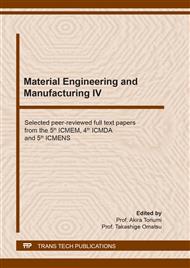[1]
Fang, X., Bando, Y., Gautam, U. K., Ye, C., & Golberg D. Inorganic semiconductor nanostructures and their field-emission applications. J Mater Chem 2008; 18: 509–522.
DOI: 10.1039/b712874f
Google Scholar
[2]
Ball P. Molecular movers and shakers. (2000).
Google Scholar
[3]
Ankamwar, B., & Surti F. Water Soluble Graphene Synthesis. Chem Sci Trans 2012; 1: 500–507.
DOI: 10.7598/cst2012.155
Google Scholar
[4]
Sun, L., & Fugetsu B. Mass production of graphene oxide from expanded graphite. Mater Lett 2013; 109: 207–210.
DOI: 10.1016/j.matlet.2013.07.072
Google Scholar
[5]
Soltani, T., & Lee BK. Low intensity-ultrasonic irradiation for highly efficient, eco-friendly and fast synthesis of graphene oxide. Ultrason Sonochem 2017; 38: 693–703.
DOI: 10.1016/j.ultsonch.2016.08.010
Google Scholar
[6]
Schafhaeutl C. LXXXVI. On the combinations of carbon with silicon and iron, and other metals, forming the different species of cast iron, steel, and malleable iron. Philos Mag Ser 3 1840; 16: 570–590.
DOI: 10.1080/14786444008650094
Google Scholar
[7]
Staudenmaier L. Verfahren zur darstellung der graphitsäure. Berichte der Dtsch Chem Gesellschaft 1898; 31: 1481–1487.
DOI: 10.1002/cber.18980310237
Google Scholar
[8]
Geim, A. K., & Novoselov KS. The rise of graphene. Nanosci Technol a Collect Rev from Nat journals 2007; 6: 183–191.
Google Scholar
[9]
Charpy G. Sur la formation de l'oxyde graphitique et la définition du graphite. C R Hebd Seances Acad Sci 1909; 148: 920–923.
Google Scholar
[10]
Hummers WS, Offeman RE. Preparation of Graphitic Oxide. J Am Chem Soc 1958; 80: 1339.
DOI: 10.1021/ja01539a017
Google Scholar
[11]
Enoki, T., Suzuki, M., & Endo M. Graphite intercalation compounds and applications. Oxford University Press, (2003).
Google Scholar
[12]
Dresselhaus MSD& G. Advances in Physics Intercalation compounds of graphite. Adv Phys 1981; 30: 139–326.
Google Scholar
[13]
Yang, W., Ratinac, K. R., Ringer, S. P., Thordarson, P., Gooding, J. J., & Braet F. Carbon nanomaterials in biosensors: should you use nanotubes or graphene? Angew Chemie Int Ed 2010; 49: 2114–38.
DOI: 10.1002/anie.200903463
Google Scholar
[14]
Lerf, A., He, H., Forster, M., & Klinowski J. Structure of graphite oxide revisited. J Phys Chem B 1998; 102: 4477–82.
DOI: 10.1021/jp9731821
Google Scholar
[15]
Lee, J., Kim, J., Kim, S., & Min DH. Biosensors based on graphene oxide and its biomedical application. Adv Drug Deliv Rev 2016; 105: 275–87.
DOI: 10.1016/j.addr.2016.06.001
Google Scholar
[16]
Hessein, A., Wang, F., Masai, H., Matsuda, K., & Abd El-Moneim A. One-step fabrication of copper sulfide nanoparticles decorated on graphene sheets as highly stable and efficient counter electrode for CdS-sensitized solar cells. Jpn J Appl Phys 2016; 55: 112301.
DOI: 10.7567/jjap.55.112301
Google Scholar
[17]
Eigler S et al. Wet chemical synthesis of graphene. Adv Mater 2013; 25: 3583–87.
Google Scholar
[18]
Sohail, M., Saleem, M., Ullah, S., Saeed, N., Afridi, A., Khan, M., & Arif M. Modified and improved Hummer's synthesis of graphene oxide for capacitors applications. Mod Electron Mater 2017; 3: 110–6.
DOI: 10.1016/j.moem.2017.07.002
Google Scholar
[19]
Chen, P., Li, H., Song, S., Weng, X., He, D., & Zhao Y. Adsorption of dodecylamine hydrochloride on graphene oxide in water. Results Phys 2017; 7: 2281–88.
DOI: 10.1016/j.rinp.2017.06.054
Google Scholar
[20]
Venkatachalam S. Spectroscopy of Polymer Nanocomposites. Elsevier Inc., (2016).
Google Scholar
[21]
Rommozzi, E., Zannotti, M., Giovannetti, R., D'Amato, C. A., Ferraro, S., Minicucci, M., ... & Di Cicco A. Reduced graphene oxide/TiO2 nanocomposite: from synthesis to characterization for efficient visible light photocatalytic applications. Catalysts 2018; 8: 598.
DOI: 10.3390/catal8120598
Google Scholar
[22]
Fan, Z., Wang, K., Wei, T., Yan, J., Song, L., & Shao B. An environmentally friendly and efficient route for the reduction of graphene oxide by aluminum powder. Carbon N Y 2010; 48: 1686–89.
DOI: 10.1016/j.carbon.2009.12.063
Google Scholar
[23]
Marcano, D. C., Kosynkin, D. V., Berlin, J. M., Sinitskii, A., Sun, Z., Slesarev, A., ... & Tour JM. Improved synthesis of graphene oxide. ACS Nano 2010; 4: 4806–14.
DOI: 10.1021/nn1006368
Google Scholar
[24]
Ciszewski, M., Mianowski, A., Nawrat, G., & Szatkowski P. Reduced graphene oxide supported antimony species for high-performance supercapacitor electrodes. Int Sch Res Not; (2014).
DOI: 10.1155/2014/826832
Google Scholar
[25]
Jabbar, A., Yasin, G., Khan, W. Q., Anwar, M. Y., Korai, R. M., Nizam, M. N., & Muhyodin G. Electrochemical deposition of nickel graphene composite coatings: effect of deposition temperature on its surface morphology and corrosion resistance. RSC Adv 2017; 7: 31100–09.
DOI: 10.1039/c6ra28755g
Google Scholar
[26]
Yáñez-Sedeño, P., Campuzano, S., & Pingarrón JM. Integrated affinity biosensing platforms on screen-printed electrodes electrografted with diazonium salts. Sensors 2018; 18: 675.
DOI: 10.3390/s18020675
Google Scholar
[27]
Jung, J. H., Cheon, D. S., Liu, F., Lee, K. B., & Seo TS. A graphene oxide based immuno‐biosensor for pathogen detection. Angew Chemie 2010; 122: 5844–47.
DOI: 10.1002/ange.201001428
Google Scholar
[28]
Singh, R., Hong, S., & Jang J. Label-free detection of influenza viruses using a reduced graphene oxide-based electrochemical immunosensor integrated with a microfluidic platform. Sci Rep 2017; 7: 1–11.
DOI: 10.1038/srep42771
Google Scholar
[29]
Apiwat, C., Luksirikul, P., Kankla, P., Pongprayoon, P., Treerattrakoon, K., Paiboonsukwong, K., ... & Japrung D. Graphene based aptasensor for glycated albumin in diabetes mellitus diagnosis and monitoring. Biosens Bioelectron 2016; 82: 140–145.
DOI: 10.1016/j.bios.2016.04.015
Google Scholar
[30]
Ueno, Y., Furukawa, K., Tin, A., & Hibino H. On-chip FRET graphene oxide aptasensor: quantitative evaluation of enhanced sensitivity by aptamer with a double-stranded DNA spacer. Anal Sci 2015; 31: 875–879.
DOI: 10.2116/analsci.31.875
Google Scholar
[31]
Lopez A, Liu J. Covalent and Noncovalent Functionalization of Graphene Oxide with DNA for Smart Sensing. Adv Intell Syst 2020; 2: 123.
Google Scholar


